[English] 日本語
 Yorodumi
Yorodumi- PDB-6tql: Cryo-EM of elastase-treated human uromodulin (UMOD)/Tamm-Horsfall... -
+ Open data
Open data
- Basic information
Basic information
| Entry | Database: PDB / ID: 6tql | |||||||||||||||
|---|---|---|---|---|---|---|---|---|---|---|---|---|---|---|---|---|
| Title | Cryo-EM of elastase-treated human uromodulin (UMOD)/Tamm-Horsfall protein (THP) filament | |||||||||||||||
 Components Components | Uromodulin | |||||||||||||||
 Keywords Keywords | STRUCTURAL PROTEIN / ZP MODULE / ZP DOMAIN / ZP-N DOMAIN / ZP-C DOMAIN / INTERDOMAIN LINKER / EGF DOMAIN / EXTRACELLULAR MATRIX / GLYCOPROTEIN / N-GLYCAN / PROTEIN FILAMENT / PROTEIN POLYMERIZATION | |||||||||||||||
| Function / homology |  Function and homology information Function and homology informationcitric acid secretion / metanephric thick ascending limb development / micturition / metanephric distal convoluted tubule development / connective tissue replacement / protein transport into plasma membrane raft / organ or tissue specific immune response / Asparagine N-linked glycosylation / collecting duct development / urea transmembrane transport ...citric acid secretion / metanephric thick ascending limb development / micturition / metanephric distal convoluted tubule development / connective tissue replacement / protein transport into plasma membrane raft / organ or tissue specific immune response / Asparagine N-linked glycosylation / collecting duct development / urea transmembrane transport / metanephric ascending thin limb development / protein localization to vacuole / regulation of protein transport / juxtaglomerular apparatus development / antibacterial innate immune response / intracellular chloride ion homeostasis / renal urate salt excretion / glomerular filtration / urate transport / renal sodium ion absorption / neutrophil migration / intracellular phosphate ion homeostasis / response to water deprivation / potassium ion homeostasis / regulation of urine volume / intracellular sodium ion homeostasis / endoplasmic reticulum organization / IgG binding / heterophilic cell-cell adhesion / extrinsic component of membrane / ciliary membrane / leukocyte cell-cell adhesion / cellular response to unfolded protein / cellular defense response / multicellular organismal response to stress / renal water homeostasis / side of membrane / : / ERAD pathway / RNA splicing / tumor necrosis factor-mediated signaling pathway / apoptotic signaling pathway / autophagy / lipid metabolic process / Golgi lumen / regulation of blood pressure / intracellular calcium ion homeostasis / spindle pole / response to lipopolysaccharide / defense response to Gram-negative bacterium / basolateral plasma membrane / cilium / apical plasma membrane / response to xenobiotic stimulus / inflammatory response / negative regulation of cell population proliferation / calcium ion binding / cell surface / endoplasmic reticulum / extracellular space / extracellular exosome / membrane Similarity search - Function | |||||||||||||||
| Biological species |  Homo sapiens (human) Homo sapiens (human) | |||||||||||||||
| Method | ELECTRON MICROSCOPY / helical reconstruction / cryo EM / Resolution: 3.96 Å | |||||||||||||||
 Authors Authors | Stsiapanava, A. / Xu, C. / Carroni, M. / Wu, B. / Jovine, L. | |||||||||||||||
| Funding support |  Sweden, Sweden,  Singapore, 4items Singapore, 4items
| |||||||||||||||
 Citation Citation |  Journal: EMBO J / Year: 2020 Journal: EMBO J / Year: 2020Title: Cryo-EM structure of native human uromodulin, a zona pellucida module polymer. Authors: Alena Stsiapanava / Chenrui Xu / Martina Brunati / Sara Zamora-Caballero / Céline Schaeffer / Marcel Bokhove / Ling Han / Hans Hebert / Marta Carroni / Shigeki Yasumasu / Luca Rampoldi / ...Authors: Alena Stsiapanava / Chenrui Xu / Martina Brunati / Sara Zamora-Caballero / Céline Schaeffer / Marcel Bokhove / Ling Han / Hans Hebert / Marta Carroni / Shigeki Yasumasu / Luca Rampoldi / Bin Wu / Luca Jovine /     Abstract: Assembly of extracellular filaments and matrices mediating fundamental biological processes such as morphogenesis, hearing, fertilization, and antibacterial defense is driven by a ubiquitous ...Assembly of extracellular filaments and matrices mediating fundamental biological processes such as morphogenesis, hearing, fertilization, and antibacterial defense is driven by a ubiquitous polymerization module known as zona pellucida (ZP) "domain". Despite the conservation of this element from hydra to humans, no detailed information is available on the filamentous conformation of any ZP module protein. Here, we report a cryo-electron microscopy study of uromodulin (UMOD)/Tamm-Horsfall protein, the most abundant protein in human urine and an archetypal ZP module-containing molecule, in its mature homopolymeric state. UMOD forms a one-start helix with an unprecedented 180-degree twist between subunits enfolded by interdomain linkers that have completely reorganized as a result of propeptide dissociation. Lateral interaction between filaments in the urine generates sheets exposing a checkerboard of binding sites to capture uropathogenic bacteria, and UMOD-based models of heteromeric vertebrate egg coat filaments identify a common sperm-binding region at the interface between subunits. #1: Journal: Proc Soc Exp Biol Med / Year: 1950 Title: Characterization and separation of an inhibitor of viral hemagglutination present in urine. #2:  Journal: Biol. Cellulaire / Year: 1980 Journal: Biol. Cellulaire / Year: 1980Title: Etude chimique et ultrastructurale de la glycoproteine de Tamm et Horsfall ou uromucoide. Authors: Delain, E. / Thiery, J.P. / Coulard, D. / Joliviene, A. / Hartman, L. #3: Journal: Science / Year: 1987 Title: Identification of human uromodulin as the Tamm-Horsfall urinary glycoprotein. Abstract: The primary structure of human uromodulin, a 616-amino acid, 85-kilodalton glycoprotein with in vitro immunosuppressive properties, was determined through isolation and characterization of ...The primary structure of human uromodulin, a 616-amino acid, 85-kilodalton glycoprotein with in vitro immunosuppressive properties, was determined through isolation and characterization of complementary DNA and genomic clones. The amino acid sequence encoded by one of the exons of the uromodulin gene has homology to the low-density-lipoprotein receptor and the epidermal growth factor precursor. Northern hybridization analyses demonstrate that uromodulin is synthesized by the kidney. Evidence is provided that uromodulin is identical to the previously characterized Tamm-Horsfall glycoprotein, the most abundant protein in normal human urine. #4: Journal: Nat Cell Biol / Year: 2002 Title: The ZP domain is a conserved module for polymerization of extracellular proteins. Authors: Luca Jovine / Huayu Qi / Zev Williams / Eveline Litscher / Paul M Wassarman /  Abstract: Many eukaryotic extracellular proteins share a sequence of unknown function, called the zona pellucida (ZP) domain. Among these proteins are the mammalian sperm receptors ZP2 and ZP3, non-mammalian ...Many eukaryotic extracellular proteins share a sequence of unknown function, called the zona pellucida (ZP) domain. Among these proteins are the mammalian sperm receptors ZP2 and ZP3, non-mammalian egg coat proteins, Tamm-Horsfall protein (THP), glycoprotein-2 (GP-2), alpha- and beta-tectorins, transforming growth factor (TGF)-beta receptor III and endoglin, DMBT-1 (deleted in malignant brain tumour-1), NompA (no-mechanoreceptor-potential-A), Dumpy and cuticlin-1 (refs 1,2). Here, we report that the ZP domain of ZP2, ZP3 and THP is responsible for polymerization of these proteins into filaments of similar supramolecular structure. Most ZP domain proteins are synthesized as precursors with carboxy-terminal transmembrane domains or glycosyl phosphatidylinositol (GPI) anchors. Our results demonstrate that the C-terminal transmembrane domain and short cytoplasmic tail of ZP2 and ZP3 are not required for secretion, but are essential for assembly. Finally, we suggest a molecular basis for dominant human hearing disorders caused by point mutations within the ZP domain of alpha-tectorin. #5: Journal: Am J Kidney Dis / Year: 2003 Title: Tamm-Horsfall glycoprotein: biology and clinical relevance. Authors: Franca Serafini-Cessi / Nadia Malagolini / Daniela Cavallone /  Abstract: Tamm-Horsfall glycoprotein (THP) is the most abundant urinary protein in mammals. Urinary excretion occurs by proteolytic cleavage of the large ectodomain of the glycosyl phosphatidylinositol- ...Tamm-Horsfall glycoprotein (THP) is the most abundant urinary protein in mammals. Urinary excretion occurs by proteolytic cleavage of the large ectodomain of the glycosyl phosphatidylinositol-anchored counterpart exposed at the luminal cell surface of the thick ascending limb of Henle's loop. We describe the physical-chemical structure of human THP and its biosynthesis and interaction with other proteins and leukocytes. The clinical relevance of THP reported here includes: (1) involvement in the pathogenesis of cast nephropathy, urolithiasis, and tubulointerstitial nephritis; (2) abnormalities in urinary excretion in renal diseases; and (3) the recent finding that familial juvenile hyperuricemic nephropathy and autosomal dominant medullary cystic kidney disease 2 arise from mutations of the THP gene. We critically examine the literature on the physiological role and mechanism(s) that promote urinary excretion of THP. Some lines of research deal with the in vitro immunoregulatory activity of THP, termed uromodulin when isolated from urine of pregnant women. However, an immunoregulatory function in vivo has not yet been established. In the most recent literature, there is renewed interest in the capacity of urinary THP to compete efficiently with urothelial cell receptors, such as uroplakins, in adhering to type 1 fimbriated Escherichia coli. This property supports the notion that abundant THP excretion in urine is promoted in the host by selective pressure to obtain an efficient defense against urinary tract infections caused by uropathogenic bacteria. #6: Journal: Proc Natl Acad Sci U S A / Year: 2004 Title: A duplicated motif controls assembly of zona pellucida domain proteins. Authors: Luca Jovine / Huayu Qi / Zev Williams / Eveline S Litscher / Paul M Wassarman /  Abstract: Many secreted eukaryotic glycoproteins that play fundamental roles in development, hearing, immunity, and cancer polymerize into filaments and extracellular matrices through zona pellucida (ZP) ...Many secreted eukaryotic glycoproteins that play fundamental roles in development, hearing, immunity, and cancer polymerize into filaments and extracellular matrices through zona pellucida (ZP) domains. ZP domain proteins are synthesized as precursors containing C-terminal propeptides that are cleaved at conserved sites. However, the consequences of this processing and the mechanism by which nascent proteins assemble are unclear. By microinjection of mutated DNA constructs into growing oocytes and mammalian cell transfection, we have identified a conserved duplicated motif [EHP (external hydrophobic patch)/IHP (internal hydrophobic patch)] regulating the assembly of mouse ZP proteins. Whereas the transmembrane domain (TMD) of ZP3 can be functionally replaced by an unrelated TMD, mutations in either EHP or IHP do not hinder secretion of full-length ZP3 but completely abolish its assembly. Because mutants truncated before the TMD are not processed, we conclude that the conserved TMD of mammalian ZP proteins does not engage them in specific interactions but is essential for C-terminal processing. Cleavage of ZP precursors results in loss of the EHP, thereby activating secreted polypeptides to assemble by using the IHP within the ZP domain. Taken together, these findings suggest a general mechanism for assembly of ZP domain proteins. #7: Journal: Annu Rev Biochem / Year: 2005 Title: Zona pellucida domain proteins. Authors: Luca Jovine / Costel C Darie / Eveline S Litscher / Paul M Wassarman /  Abstract: Many eukaryotic proteins share a sequence designated as the zona pellucida (ZP) domain. This structural element, present in extracellular proteins from a wide variety of organisms, from nematodes to ...Many eukaryotic proteins share a sequence designated as the zona pellucida (ZP) domain. This structural element, present in extracellular proteins from a wide variety of organisms, from nematodes to mammals, consists of approximately 260 amino acids with eight conserved cysteine (Cys) residues and is located close to the C terminus of the polypeptide. ZP domain proteins are often glycosylated, modular structures consisting of multiple types of domains. Predictions can be made about some of the structural features of the ZP domain and ZP domain proteins. The functions of ZP domain proteins vary tremendously, from serving as structural components of egg coats, appendicularian mucous houses, and nematode dauer larvae, to serving as mechanotransducers in flies and receptors in mammals and nonmammals. Generally, ZP domain proteins are present in filaments and/or matrices, which is consistent with the role of the domain in protein polymerization. A general mechanism for assembly of ZP domain proteins has been presented. It is likely that the ZP domain plays a common role despite its presence in proteins of widely diverse functions. #8: Journal: Mol Biol Cell / Year: 2009 Title: Analysis of uromodulin polymerization provides new insights into the mechanisms regulating ZP domain-mediated protein assembly. Authors: Céline Schaeffer / Sara Santambrogio / Simone Perucca / Giorgio Casari / Luca Rampoldi /  Abstract: Uromodulin is the most abundant protein secreted in urine, in which it is found as a high-molecular-weight polymer. Polymerization occurs via its zona pellucida (ZP) domain, a conserved module shared ...Uromodulin is the most abundant protein secreted in urine, in which it is found as a high-molecular-weight polymer. Polymerization occurs via its zona pellucida (ZP) domain, a conserved module shared by many extracellular eukaryotic proteins that are able to assemble into matrices. In this work, we identified two motifs in uromodulin, mapping in the linker region of the ZP domain and in between protein cleavage and glycosylphosphatidylinositol (GPI)-anchoring sites, which regulate its polymerization. Indeed, mutations in either module led to premature intracellular polymerization of a soluble uromodulin isoform, demonstrating the inhibitory role of these motifs for ZP domain-mediated protein assembly. Proteolytic cleavage separating the external motif from the mature monomer is necessary to release the inhibitory function and allow protein polymerization. Moreover, we report absent or abnormal assembly into filaments of GPI-anchored uromodulin mutated in either the internal or the external motif. This effect is due to altered processing on the plasma membrane, demonstrating that the presence of the two modules has not only an inhibitory function but also can positively regulate protein polymerization. Our data expand previous knowledge on the control of ZP domain function and suggest a common mechanism regulating polymerization of ZP domain proteins. #9:  Journal: Cell / Year: 2010 Journal: Cell / Year: 2010Title: Insights into egg coat assembly and egg-sperm interaction from the X-ray structure of full-length ZP3. Authors: Ling Han / Magnus Monné / Hiroki Okumura / Thomas Schwend / Amy L Cherry / David Flot / Tsukasa Matsuda / Luca Jovine /  Abstract: ZP3, a major component of the zona pellucida (ZP) matrix coating mammalian eggs, is essential for fertilization by acting as sperm receptor. By retaining a propeptide that contains a polymerization- ...ZP3, a major component of the zona pellucida (ZP) matrix coating mammalian eggs, is essential for fertilization by acting as sperm receptor. By retaining a propeptide that contains a polymerization-blocking external hydrophobic patch (EHP), we determined the crystal structure of an avian homolog of ZP3 at 2.0 Å resolution. The structure unveils the fold of a complete ZP domain module in a homodimeric arrangement required for secretion and reveals how EHP prevents premature incorporation of ZP3 into the ZP. This suggests mechanisms underlying polymerization and how local structural differences, reflected by alternative disulfide patterns, control the specificity of ZP subunit interaction. Close relative positioning of a conserved O-glycan important for sperm binding and the hypervariable, positively selected C-terminal region of ZP3 suggests a concerted role in the regulation of species-restricted gamete recognition. Alternative conformations of the area around the O-glycan indicate how sperm binding could trigger downstream events via intramolecular signaling. #10: Journal: Kidney Int / Year: 2011 Title: The rediscovery of uromodulin (Tamm-Horsfall protein): from tubulointerstitial nephropathy to chronic kidney disease. Authors: Luca Rampoldi / Francesco Scolari / Antonio Amoroso / Gianmarco Ghiggeri / Olivier Devuyst /  Abstract: Uromodulin (Tamm-Horsfall protein) is the most abundant protein excreted in the urine under physiological conditions. It is exclusively produced in the kidney and secreted into the urine via ...Uromodulin (Tamm-Horsfall protein) is the most abundant protein excreted in the urine under physiological conditions. It is exclusively produced in the kidney and secreted into the urine via proteolytic cleavage. Its biological function is still not fully understood. Uromodulin has been linked to water/electrolyte balance and to kidney innate immunity. Also, studies in knockout mice demonstrated that it has a protective role against urinary tract infections and renal stone formation. Mutations in the gene encoding uromodulin lead to rare autosomal dominant diseases, collectively referred to as uromodulin-associated kidney diseases. They are characterized by progressive tubulointerstitial damage, impaired urinary concentrating ability, hyperuricemia, renal cysts, and progressive renal failure. Novel in vivo studies point at intracellular accumulation of mutant uromodulin as a key primary event in the disease pathogenesis. Recently, genome-wide association studies identified uromodulin as a risk factor for chronic kidney disease (CKD) and hypertension, and suggested that the level of uromodulin in the urine could represent a useful biomarker for the development of CKD. In this review, we summarize these recent investigations, ranging from invalidation studies in mouse to Mendelian disorders and genome-wide associations, which led to a rediscovery of uromodulin and boosted the scientific and clinical interest for this long discovered molecule. #11: Journal: Elife / Year: 2015 Title: The serine protease hepsin mediates urinary secretion and polymerisation of Zona Pellucida domain protein uromodulin. Authors: Martina Brunati / Simone Perucca / Ling Han / Angela Cattaneo / Francesco Consolato / Annapaola Andolfo / Céline Schaeffer / Eric Olinger / Jianhao Peng / Sara Santambrogio / Romain Perrier ...Authors: Martina Brunati / Simone Perucca / Ling Han / Angela Cattaneo / Francesco Consolato / Annapaola Andolfo / Céline Schaeffer / Eric Olinger / Jianhao Peng / Sara Santambrogio / Romain Perrier / Shuo Li / Marcel Bokhove / Angela Bachi / Edith Hummler / Olivier Devuyst / Qingyu Wu / Luca Jovine / Luca Rampoldi /     Abstract: Uromodulin is the most abundant protein in the urine. It is exclusively produced by renal epithelial cells and it plays key roles in kidney function and disease. Uromodulin mainly exerts its function ...Uromodulin is the most abundant protein in the urine. It is exclusively produced by renal epithelial cells and it plays key roles in kidney function and disease. Uromodulin mainly exerts its function as an extracellular matrix whose assembly depends on a conserved, specific proteolytic cleavage leading to conformational activation of a Zona Pellucida (ZP) polymerisation domain. Through a comprehensive approach, including extensive characterisation of uromodulin processing in cellular models and in specific knock-out mice, we demonstrate that the membrane-bound serine protease hepsin is the enzyme responsible for the physiological cleavage of uromodulin. Our findings define a key aspect of uromodulin biology and identify the first in vivo substrate of hepsin. The identification of hepsin as the first protease involved in the release of a ZP domain protein is likely relevant for other members of this protein family, including several extracellular proteins, as egg coat proteins and inner ear tectorins. #12:  Journal: Proc Natl Acad Sci U S A / Year: 2016 Journal: Proc Natl Acad Sci U S A / Year: 2016Title: A structured interdomain linker directs self-polymerization of human uromodulin. Authors: Marcel Bokhove / Kaoru Nishimura / Martina Brunati / Ling Han / Daniele de Sanctis / Luca Rampoldi / Luca Jovine /    Abstract: Uromodulin (UMOD)/Tamm-Horsfall protein, the most abundant human urinary protein, plays a key role in chronic kidney diseases and is a promising therapeutic target for hypertension. Via its bipartite ...Uromodulin (UMOD)/Tamm-Horsfall protein, the most abundant human urinary protein, plays a key role in chronic kidney diseases and is a promising therapeutic target for hypertension. Via its bipartite zona pellucida module (ZP-N/ZP-C), UMOD forms extracellular filaments that regulate kidney electrolyte balance and innate immunity, as well as protect against renal stones. Moreover, salt-dependent aggregation of UMOD filaments in the urine generates a soluble molecular net that captures uropathogenic bacteria and facilitates their clearance. Despite the functional importance of its homopolymers, no structural information is available on UMOD and how it self-assembles into filaments. Here, we report the crystal structures of polymerization regions of human UMOD and mouse ZP2, an essential sperm receptor protein that is structurally related to UMOD but forms heteropolymers. The structure of UMOD reveals that an extensive hydrophobic interface mediates ZP-N domain homodimerization. This arrangement is required for filament formation and is directed by an ordered ZP-N/ZP-C linker that is not observed in ZP2 but is conserved in the sequence of deafness/Crohn's disease-associated homopolymeric glycoproteins α-tectorin (TECTA) and glycoprotein 2 (GP2). Our data provide an example of how interdomain linker plasticity can modulate the function of structurally similar multidomain proteins. Moreover, the architecture of UMOD rationalizes numerous pathogenic mutations in both UMOD and TECTA genes. #13: Journal: Curr Top Dev Biol / Year: 2018 Title: Structure of Zona Pellucida Module Proteins. Authors: Marcel Bokhove / Luca Jovine /  Abstract: The egg coat, an extracellular matrix made up of glycoprotein filaments, plays a key role in animal fertilization by acting as a gatekeeper for sperm. Egg coat components polymerize using a common ...The egg coat, an extracellular matrix made up of glycoprotein filaments, plays a key role in animal fertilization by acting as a gatekeeper for sperm. Egg coat components polymerize using a common zona pellucida (ZP) "domain" module that consists of two related immunoglobulin-like domains, called ZP-N and ZP-C. The ZP module has also been recognized in a large number of other secreted proteins with different biological functions, whose mutations are linked to severe human diseases. During the last decade, tremendous progress has been made toward understanding the atomic architecture of the ZP module and the structural basis of its polymerization. Moreover, sperm-binding regions at the N-terminus of mollusk and mammalian egg coat subunits were found to consist of domain repeats that also adopt a ZP-N fold. This discovery revealed an unexpected link between invertebrate and vertebrate fertilization and led to the first structure of an egg coat-sperm protein recognition complex. In this review we summarize these exciting findings, discuss their functional implications, and outline future challenges that must be addressed in order to develop a comprehensive view of this family of biomedically important extracellular molecules. #14:  Journal: bioRxiv / Year: 2020 Journal: bioRxiv / Year: 2020Title: Cryo-EM structure of native human uromodulin, a zona pellucida module polymer. Authors: Stsiapanava, A. / Xu, C. / Brunati, M. / Zamora-Caballero, S. / Schaeffer, C. / Han, L. / Carroni, M. / Yasumasu, S. / Rampoldi, L. / Wu, B. / Jovine, L. | |||||||||||||||
| History |
|
- Structure visualization
Structure visualization
| Movie |
 Movie viewer Movie viewer |
|---|---|
| Structure viewer | Molecule:  Molmil Molmil Jmol/JSmol Jmol/JSmol |
- Downloads & links
Downloads & links
- Download
Download
| PDBx/mmCIF format |  6tql.cif.gz 6tql.cif.gz | 221.6 KB | Display |  PDBx/mmCIF format PDBx/mmCIF format |
|---|---|---|---|---|
| PDB format |  pdb6tql.ent.gz pdb6tql.ent.gz | 176.2 KB | Display |  PDB format PDB format |
| PDBx/mmJSON format |  6tql.json.gz 6tql.json.gz | Tree view |  PDBx/mmJSON format PDBx/mmJSON format | |
| Others |  Other downloads Other downloads |
-Validation report
| Summary document |  6tql_validation.pdf.gz 6tql_validation.pdf.gz | 1.3 MB | Display |  wwPDB validaton report wwPDB validaton report |
|---|---|---|---|---|
| Full document |  6tql_full_validation.pdf.gz 6tql_full_validation.pdf.gz | 1.3 MB | Display | |
| Data in XML |  6tql_validation.xml.gz 6tql_validation.xml.gz | 25.8 KB | Display | |
| Data in CIF |  6tql_validation.cif.gz 6tql_validation.cif.gz | 32.5 KB | Display | |
| Arichive directory |  https://data.pdbj.org/pub/pdb/validation_reports/tq/6tql https://data.pdbj.org/pub/pdb/validation_reports/tq/6tql ftp://data.pdbj.org/pub/pdb/validation_reports/tq/6tql ftp://data.pdbj.org/pub/pdb/validation_reports/tq/6tql | HTTPS FTP |
-Related structure data
| Related structure data |  10554MC  6tqkC M: map data used to model this data C: citing same article ( |
|---|---|
| Similar structure data |
- Links
Links
- Assembly
Assembly
| Deposited unit | 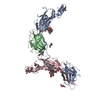
| |||||||||||||||||||||||||||||||||||||||||||||||||||||
|---|---|---|---|---|---|---|---|---|---|---|---|---|---|---|---|---|---|---|---|---|---|---|---|---|---|---|---|---|---|---|---|---|---|---|---|---|---|---|---|---|---|---|---|---|---|---|---|---|---|---|---|---|---|---|
| 1 |
| |||||||||||||||||||||||||||||||||||||||||||||||||||||
| Noncrystallographic symmetry (NCS) | NCS domain:
NCS domain segments:
NCS ensembles :
|
- Components
Components
| #1: Protein | Mass: 33211.594 Da / Num. of mol.: 3 / Source method: isolated from a natural source / Source: (natural)  Homo sapiens (human) / Plasmid details: Urine / References: UniProt: P07911 Homo sapiens (human) / Plasmid details: Urine / References: UniProt: P07911#2: Polysaccharide | Source method: isolated from a genetically manipulated source #3: Polysaccharide | beta-D-galactopyranose-(1-4)-2-acetamido-2-deoxy-beta-D-glucopyranose-(1-2)-[2-acetamido-2-deoxy- ...beta-D-galactopyranose-(1-4)-2-acetamido-2-deoxy-beta-D-glucopyranose-(1-2)-[2-acetamido-2-deoxy-beta-D-glucopyranose-(1-4)]alpha-D-mannopyranose-(1-6)-[2-acetamido-2-deoxy-beta-D-glucopyranose-(1-2)-[2-acetamido-2-deoxy-beta-D-glucopyranose-(1-4)]alpha-D-mannopyranose-(1-3)]beta-D-mannopyranose-(1-4)-2-acetamido-2-deoxy-beta-D-glucopyranose-(1-4)-2-acetamido-2-deoxy-beta-D-glucopyranose | Source method: isolated from a genetically manipulated source #4: Polysaccharide | 2-acetamido-2-deoxy-beta-D-glucopyranose-(1-2)-[2-acetamido-2-deoxy-beta-D-glucopyranose-(1-4)] ...2-acetamido-2-deoxy-beta-D-glucopyranose-(1-2)-[2-acetamido-2-deoxy-beta-D-glucopyranose-(1-4)]alpha-D-mannopyranose-(1-3)-[2-acetamido-2-deoxy-beta-D-glucopyranose-(1-4)-alpha-D-mannopyranose-(1-6)]beta-D-mannopyranose-(1-4)-2-acetamido-2-deoxy-beta-D-glucopyranose-(1-4)-2-acetamido-2-deoxy-beta-D-glucopyranose | Source method: isolated from a genetically manipulated source #5: Sugar | Has ligand of interest | N | Has protein modification | Y | |
|---|
-Experimental details
-Experiment
| Experiment | Method: ELECTRON MICROSCOPY |
|---|---|
| EM experiment | Aggregation state: FILAMENT / 3D reconstruction method: helical reconstruction |
- Sample preparation
Sample preparation
| Component | Name: Uromodulin (UMOD)/Tamm-Horsfall protein (THP) / Type: COMPLEX / Details: Elastase-resistant fragment / Entity ID: #1 / Source: NATURAL |
|---|---|
| Source (natural) | Organism:  Homo sapiens (human) Homo sapiens (human) |
| Buffer solution | pH: 7 |
| Buffer component | Conc.: 10 mM / Name: Na-HEPES / Formula: C8H17N2NaO4S |
| Specimen | Conc.: 1 mg/ml / Embedding applied: NO / Shadowing applied: NO / Staining applied: NO / Vitrification applied: YES Details: Obtained by limited proteolysis of purified native human uromodulin filaments with porcine pancreatic elastase. |
| Specimen support | Grid material: GOLD / Grid mesh size: 300 divisions/in. / Grid type: Quantifoil R2/2 |
| Vitrification | Instrument: FEI VITROBOT MARK IV / Cryogen name: ETHANE / Chamber temperature: 294 K |
- Electron microscopy imaging
Electron microscopy imaging
| Experimental equipment |  Model: Titan Krios / Image courtesy: FEI Company |
|---|---|
| Microscopy | Model: FEI TITAN KRIOS |
| Electron gun | Electron source:  FIELD EMISSION GUN / Accelerating voltage: 300 kV / Illumination mode: FLOOD BEAM FIELD EMISSION GUN / Accelerating voltage: 300 kV / Illumination mode: FLOOD BEAM |
| Electron lens | Mode: BRIGHT FIELD / Nominal magnification: 165000 X / Calibrated defocus min: 1400 nm / Calibrated defocus max: 3000 nm / Cs: 2.7 mm / C2 aperture diameter: 70 µm |
| Specimen holder | Cryogen: NITROGEN / Specimen holder model: FEI TITAN KRIOS AUTOGRID HOLDER |
| Image recording | Average exposure time: 6 sec. / Electron dose: 45 e/Å2 / Detector mode: COUNTING / Film or detector model: GATAN K2 QUANTUM (4k x 4k) / Num. of grids imaged: 1 / Num. of real images: 5683 |
| EM imaging optics | Energyfilter name: GIF Bioquantum / Energyfilter slit width: 20 eV |
| Image scans | Movie frames/image: 40 |
- Processing
Processing
| Software |
| ||||||||||||||||||||||||||||||||||||||||||||||||||||||||||||
|---|---|---|---|---|---|---|---|---|---|---|---|---|---|---|---|---|---|---|---|---|---|---|---|---|---|---|---|---|---|---|---|---|---|---|---|---|---|---|---|---|---|---|---|---|---|---|---|---|---|---|---|---|---|---|---|---|---|---|---|---|---|
| EM software |
| ||||||||||||||||||||||||||||||||||||||||||||||||||||||||||||
| CTF correction | Type: PHASE FLIPPING AND AMPLITUDE CORRECTION | ||||||||||||||||||||||||||||||||||||||||||||||||||||||||||||
| Helical symmerty | Angular rotation/subunit: -179.9 ° / Axial rise/subunit: 62.7 Å / Axial symmetry: C1 | ||||||||||||||||||||||||||||||||||||||||||||||||||||||||||||
| Particle selection | Num. of particles selected: 252438 | ||||||||||||||||||||||||||||||||||||||||||||||||||||||||||||
| 3D reconstruction | Resolution: 3.96 Å / Resolution method: OTHER / Num. of particles: 94937 / Details: PHENIX ResolveCryoEM FSCref=0.5 / Symmetry type: HELICAL | ||||||||||||||||||||||||||||||||||||||||||||||||||||||||||||
| Atomic model building | B value: 171 / Protocol: FLEXIBLE FIT / Space: REAL | ||||||||||||||||||||||||||||||||||||||||||||||||||||||||||||
| Atomic model building | 3D fitting-ID: 1 / Accession code: 6TQK / Initial refinement model-ID: 1 / PDB-ID: 6TQK / Source name: PDB / Type: experimental model
| ||||||||||||||||||||||||||||||||||||||||||||||||||||||||||||
| Refinement | Cross valid method: NONE Stereochemistry target values: GeoStd + Monomer Library + CDL v1.2 | ||||||||||||||||||||||||||||||||||||||||||||||||||||||||||||
| Displacement parameters | Biso mean: 179.85 Å2 | ||||||||||||||||||||||||||||||||||||||||||||||||||||||||||||
| Refine LS restraints |
| ||||||||||||||||||||||||||||||||||||||||||||||||||||||||||||
| Refine LS restraints NCS |
|
 Movie
Movie Controller
Controller



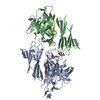
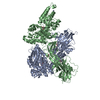

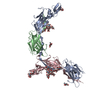

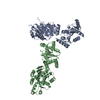
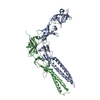

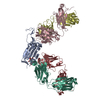
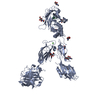
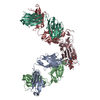
 PDBj
PDBj






